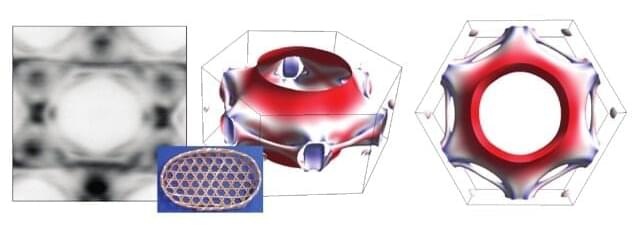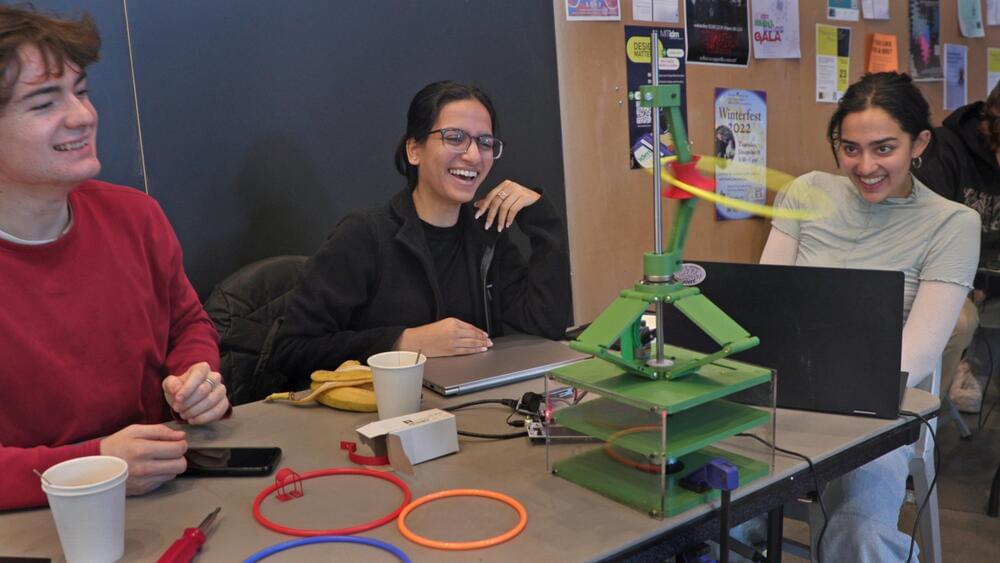Boson sampling was once considered a problem looking for a solution. Now, it might be the bridge that brings quantum computing to the blockchain.



An international research team has succeeded for the first time in measuring the electron spin in matter—i.e., the curvature of space in which electrons live and move—within “kagome materials,” a new class of quantum materials.
The results obtained—published in Nature Physics —could revolutionize the way quantum materials are studied in the future, opening the door to new developments in quantum technologies, with possible applications in a variety of technological fields, from renewable energy to biomedicine, from electronics to quantum computers.
Success was achieved by an international collaboration of scientists, in which Domenico Di Sante, professor at the Department of Physics and Astronomy “Augusto Righi,” participated for the University of Bologna as part of his Marie Curie BITMAP research project. He was joined by colleagues from CNR-IOM Trieste, Ca’ Foscari University of Venice, University of Milan, University of Würzburg (Germany), University of St. Andrews (UK), Boston College and University of Santa Barbara (U.S.).
The Chinese Communist Party is drafting new rules to force service providers to restrict the kind of information sent via filesharing services like AirDrop and Bluetooth.
In a move that will surprise nobody, the Chinese Communist Party (CCP) is making moves to restrict the use of wireless file-sharing services like AirDrop and Bluetooth to restrict the spread of “illegal and undesirable” information.
Over the last few years, protestors who oppose the… More.
Bymuratdeniz/iStock.
Over the last few years, protestors who oppose the government have frequently utilized AirDrop to coordinate and distribute their political demands. For example, certain activists employed this tool on the Shanghai subway last October to share posters criticizing Xi Jinping, just as the Chinese president anticipated his third term as the country’s leader. AirDrop has also gained popularity among activists due to its reliance on Bluetooth connections between nearby devices. This allows individuals to share information with strangers without disclosing their details or relying on a centralized network that can be monitored.

Zuckerberg addressed Apple’s headset unveiling in a meeting with Meta employees, telling them that it ‘could be the vision of the future of computing, but like, it’s not the one that I want.’
Mark Zuckerberg doesn’t seem fazed by Apple’s introduction of the Vision Pro.
In a companywide meeting with Meta employees today that The Verge watched, the CEO said Apple’s device didn’t present any major breakthroughs in technology that Meta hadn’t “already explored” and that its vision for how people will use the device is “not the one that I want.” He also pointed to the fact that Meta’s upcoming Quest 3 headset will be much cheaper, at $499 compared to the Vision Pro’s $3,499 price tag, giving Meta… More.
One takeaway: “it costs seven times more.”

Meta this week showcased its work on new generative AI technologies for its consumer products, including Instagram, WhatsApp and Messenger, as well as those being used internally at the company. At an all-hands meeting, Meta CEO Mark Zuckerberg announced several AI technologies in various stages of development, including AI chatbots for Messenger and WhatsApp, AI stickers, and other tools that would allow photo editing in Instagram Stories, in addition to internal-only products, like an AI productivity assistant and an experimental interface for interacting with AI agents, powered by Meta’s large language model LLaMA.
Axios had first reported the news of the consumer-facing AI agents and photo-editing tools, specifically. But the larger presentation touched on a number of areas where Meta is developing AI technologies and commentary about where it sees this space going.
In addition, the company announced it’s planning to host an internal AI hackathon in July focused on generative AI, which could result in new AI products that eventually make their way to Meta’s users.

New technologies will be able to wrap around legacy bank systems and create a new layer of data attribution, ushering in a modern era for accounting and business finance.
AI-enabled accounting takes a proactive approach to processing financial information. This means reducing the likelihood of errors, ensuring greater consistency across the ledger and allowing continuous data monitoring.
Where once bad or missing transaction information led to messy books and uninformed business decisions, advances in AI can now use context clues to categorize transactions accurately from the outset—getting us to a world where transactions can actually be “self-documenting.” This will make accountants’ and business owners’ lives easier while improving overall operating efficiencies.


Visits with a 24/7, co-payment-free telemedicine program established by Penn Medicine for its employees were 23% less expensive than in-person visits for the same conditions, according to a new analysis published in the American Journal of Managed Care.
Researchers at the Perelman School of Medicine at the University of Pennsylvania found that the per-visit costs for the telemedicine program, called Penn Medicine OnDemand, averaged $380 while in-person encounters in primary care offices, emergency departments, or urgent care clinics during the same timeframe cost $493 to conduct, a $113 difference per patient.
“The conditions most often handled by OnDemand are low acuity—non-urgent or semi-urgent issues like respiratory infections, sinus infections, and allergies—but incredibly common, so any kind of cost reduction can make a huge difference for controlling employee benefit costs,” said the study’s lead researcher, Krisda Chaiyachati, MD, an adjunct assistant professor of Medicine at Penn Medicine, who previously served as medical director of Penn Medicine OnDemand and now is the physician lead for Value-based Care and Innovation at Verily. “This research shows the clear financial benefits when hospitals and health systems offer telemedicine services directly to their own employees.”

Enter Kim’s class, 2.74 (Bio-Inspired Robotics).
According to Kim, researchers need to understand this cognitive bias, this tendency toward anthropomorphism, in order to even begin developing robots that can help humans with their physical movements. While Kim’s research interest is in building robots that could help people, such as the elderly in an aging population with fewer young people to perform services, such advancement is not even possible without understanding biology, biomechanics, and how much we don’t understand about our own everyday movements.
“One big thing students should learn in this class is not necessarily to understand how we move our body but the fact that we don’t understand how we move,” Kim says. “One of our ultimate goals in robotics is to develop robots that help elderly people by mimicking how we use our arms and legs, but if you don’t realize how little we know about how we move, we cannot even start tackling this problem.”

Google announced the general availability (GA) of generative AI services based on Vertex AI, the Machine Learning Platform as a Service (ML PaaS) offering from Google Cloud. With the service becoming GA, enterprises and organizations could integrate the platform’s capabilities with their applications.
With this update, developers can use several new tools and models, such as the world completion model driven by PaLM 2, the Embeddings API for text, and other foundation models in the Model Garden. They can also leverage the tools available within the Generative AI Studio to fine-tune and deploy customized models. Google claims that enterprise-grade data governance, security, and safety features are also built into the Vertex AI platform. This provides confidence to customers in consuming the foundation models, customizing them with their own data, and building generative AI applications.
Customers can use the Model Garden to access and evaluate base models from Google and its partners. There are over 60 models, with pals for adding newer models in the future. Also, the Codey model for code completion, code generation, and chat, announced at the Google I/O conference in May, is now available for public preview.